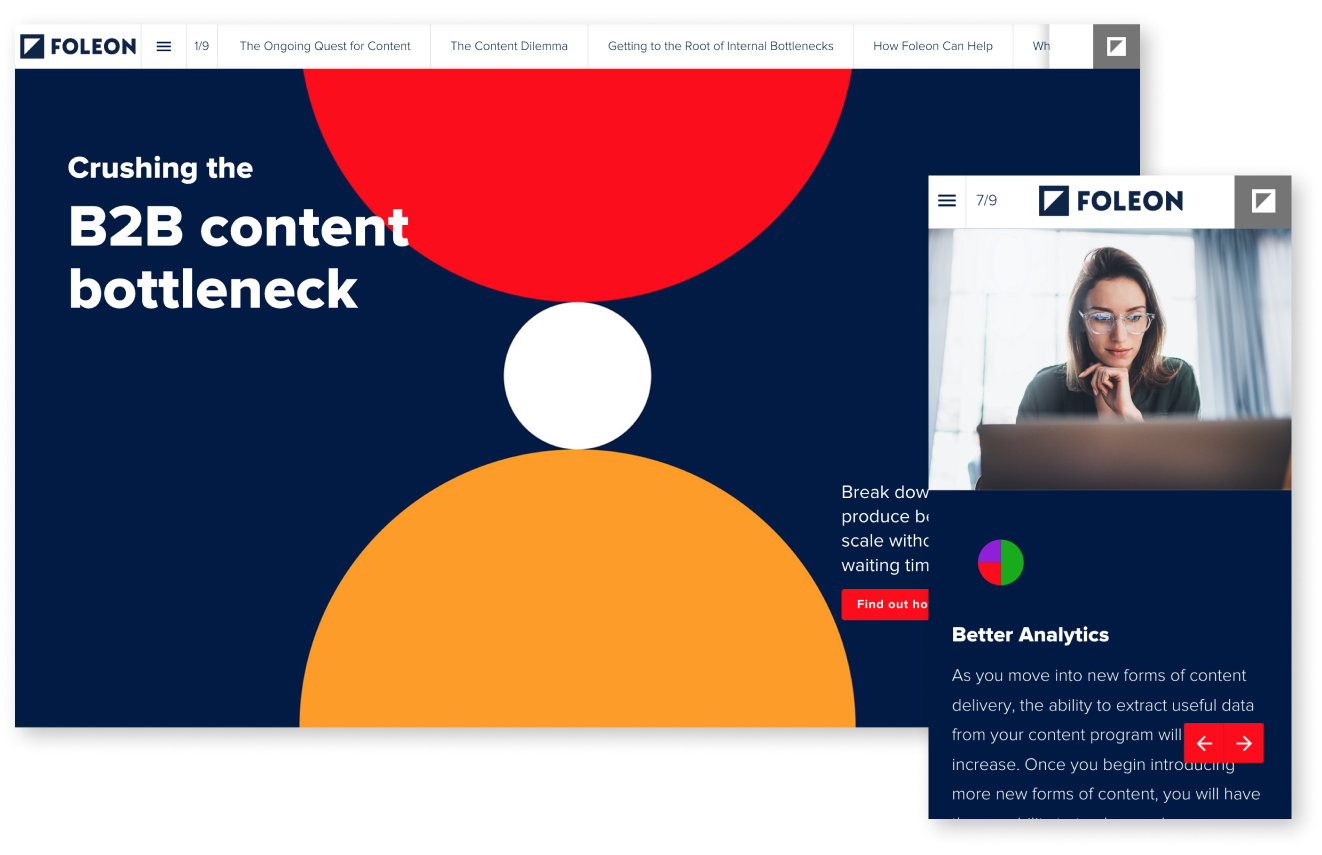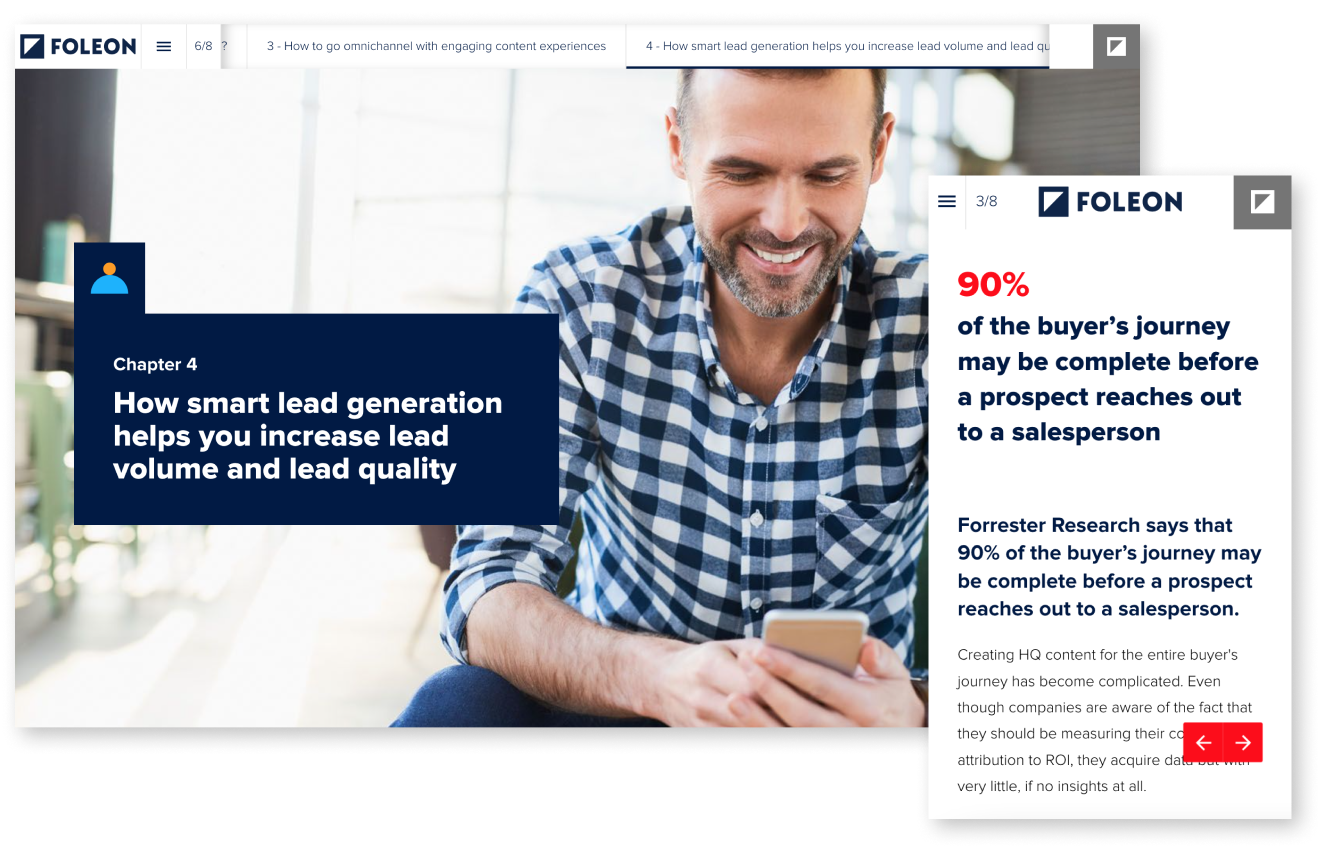Thinking of creating eBooks to showcase your brand, or need to improve your current output? Want expert tips to make sure it hits the right notes with your target audience? You’ve landed on the right page!
The team here at Foleon loves eBooks. This fabulous content format is adaptable and engaging, supports a variety of interactive media, and is a valuable and effective tool at various stages in the buyer journey.
So, if you want to drive high-quality traffic to your website, get noticed on social media, boost your SEO, generate more leads and increase sales, e-books are a great choice for you. eBooks take a little time to produce to a high standard, but with access to the best content platforms and a bit of practice with content creation processes, you’ll be flying in no time at all.
This guide will talk you through every step of creating and formatting an eBook that delights readers and gives you a competitive advantage. Read on to discover top tips for creating and formatting the perfect eBooks to promote your business.
What is an eBook?
An eBook is an electronic or online version of a brochure, guide, or publication. eBooks are commonly used as sales and marketing collateral tools and should be designed to be read on a variety of screen sizes and devices.
Who should create or use eBooks?
Any business or individual who wants to communicate information in an engaging, entertaining, and shareable format should consider creating an eBook. The creation and distribution of eBooks is usually the responsibility of the marketing team, but there are several benefits to getting input from other departments.
For example, if you want to produce a guide to a particular product, why not bring in your product development or design team to ensure you have addressed all barriers to usage? Or, if you are developing a promotional eBook, why not speak to your sales or customer service team to see which features or benefits customers love most? They might even be able to help you identify a client or customer to use for a testimonial or case study.
Want to know more about avoiding unnecessary production bottlenecks by democratizing content? Our very own Sean Filidis explains all.

The eBook experience versus print – which is better for your business?
As we mentioned at the start, eBooks are a favorite here at Foleon. But that’s not to say that print doesn’t have its place. So, which is better for your business?
We’d recommend using a printed book if…
You want a physical article to hand out at events or in-store.
You know that your customers and/or prospective customers prefer to read print collateral and certain stages in the buyer journey. (Though we always encourage you to challenge what you believe you know about your audience — things change!)
We’d recommend producing an eBook if you…
Want to include interactive elements that will bring your content to life, such as animations, video, charts and graphs, checklists, and so forth.
Would like to be able to track how readers are engaging with the content.
Want to be able to personalize or adapt and distribute the content quickly and easily.
Need a content format that is easy to share and gets great engagement on social media.
Don’t have specialist design expertise but want to be able to produce a professional, slick and elegant promotional tool.
eBooks can be produced in print or digital form. But as you can see, there are some very compelling reasons to opt for a digital eBook. If you go down the digital route, don’t resort to tired old PDFs. Foleon’s CEO, Daan Rejinders, explains why it's best to opt for a responsive, interactive format for your eBooks.
What should you include in an eBook?
The elements you include in your eBook depend on the nature of the content, your audience’s needs, and your goals and objectives. We’ll explore a potential outline to consider in a later section, but when deciding what to include, make sure you keep the reader’s journey, priorities, and interests in mind. There’s no use starting the eBook with a raft of information about your company and team if the person has accessed the eBook to discover how to use a product.
Make sure you include a compelling title and subtitle that clearly explains what the reader will get from the content. You should also include consistent branding elements throughout the eBook that enhance the content but don’t distract from it. Always make sure you give the reader somewhere to go after the eBook, a call to action to contact you for a free consultation or more information. Or perhaps a link to a video or demo sign-up form. If you’re using Foleon, you can embed your form directly in your ebook and sync it up with your CRM — check out an example here.
Deciding which content to include in your eBook can be a challenge. You want it to be comprehensive enough to give the reader all the necessary information, but you don’t want to overload them with too much detail. One of the great things about interactive eBooks is the ability to link to additional content from the main pages. So, if you want to give the user the option to find out more about the technical aspects behind your product, you can simply add a link to the relevant webpage. If you think some readers would be interested in an in-depth case study, you can direct them to it from the features and benefits page of your eBook.
When you use a content creation platform like Foleon’s, you’ll be able to monitor engagement on each page and see if readers are accessing the links and adjust the content accordingly. You can even use these insights to personalize follow-up content to a specific lead.
Sometimes the best way to get inspired is to check out some real-life examples of eBooks. Foleon’s Director of Brand and Communications, Julie Alexander, lists 7 of her favorite digital brochures.
How to create an outline for an eBook
Great eBooks need a great structure. No matter how pressing your deadline is, you must set aside a good amount of time to create a solid outline for your eBook. This will ensure your content has a coherent structure, that each page has a purpose and that the information is prioritized and presented well. It will also make adapting and personalizing the content much easier and, most importantly, will vastly improve the user experience.
The layout will depend on the subject matter and topics you are covering as well as the needs of your audience. Here are some tips for creating an outline for your eBook.
- Start by getting a clear idea about your goals and objectives for the eBook. What do you want to achieve with the content, and what do you want your reader to do once they finish reading it? How will it complement and enhance your wider sales and marketing strategy?
- Create a compelling hook to capture your audience’s attention and display this front and center in the eBook; the title page, for example. Don’t use any language that is unnecessarily sensational or that doesn’t represent the content well. Keep it short, to the point, and add a bit of intrigue, if appropriate.
- Think about where the eBook will be positioned in the customer journey. What information will get your lead’s attention in the opening pages; what will they want to hear about next? Test out your proposed running order on a few colleagues or peers to see if you have nailed it. Remember, if you choose a great content creation platform with powerful baked-in analytics, you’ll be able to test the content on a few leads and make adjustments before releasing it into the wider world.
- Create a page plan and map the content to each page, ensuring the priority information is at the top. Create an eye-catching headline that clearly shows the reader what they can expect from each section. Make a note to yourself to link to each section from the contents page and between sections if it makes sense to your design.
- Be strict about the amount of content that you include. Don’t risk overwhelming your lead with too much information or content that isn’t relevant at this stage. Link to external content with further, relevant information rather than cluttering up the page.
Want to skyrocket sales and delight your customers? Find out how Foleon’s digital brochures help you make it happen.
How to write a great eBook
With your structure in place, it's time to start writing your content. Here are some tips for crafting an eBook with impact.
Choose your topic. Your target audience is subjected to a lot of content daily, so you need to make sure the subject matter, and your spin on it, is original and will give them something new. If your eBook is a promotional tool, ask your sales team about the most pressing challenges their leads face. Why is your brand the right one to help them, and how can you best assure them of that? If the eBook is thought leadership-focused, make sure you are covering a genuinely unique and current topic and that you have some interesting data or findings to bolster the content.
Get the right tone of voice. This is a good time to bring in your customer personas. Think about the language your audience uses and which tone of voice and messaging they will respond to best. So, no unnecessary jargon and only use language they will relate to and will make them feel understood. If you need to appeal to a number of personas, why not create a different version for each? Your sales team will certainly thank you for it when those hot leads come flooding in!
Get to the point. We’ve mentioned the importance of keeping the content concise a few times, but it bears repeating. Too much information could dilute your key messaging and reduce impact.
Focus on the benefits. Your potential customers are primarily motivated by how you could make their lives easier or better. Be clear about how you can solve their problems, and where appropriate, tell the story of how you can make it happen through case studies or testimonials.
Give them a reason to read on. Today’s content consumers are easily distracted. The more time leads spend reading your eBook, the better chance you have to convince them that you are the right choice for them. Include prompts in the copy and at the end of each section to show the benefits of staying engaged with the content. Mention topics you will discuss later on and why they matter. For example, if you’re wondering how to design your eBook, don’t worry; we will cover that in the next section!
Personalize the content. Show your lead you understand their challenges and value their time by creating personalized eBook content that addresses individual needs. If that sounds like a lot of work, it needn’t be. Find out how to scale content production successfully in our free guide.
Make it a great content experience. Every content creator knows that overloading your reader with huge chunks of text is a no-no. Keep sentences short and snappy, including plenty of page breaks, bullets, lists, quotation boxes, etc. Use the same font throughout (two at most) and opt for a font size of around 12 points or 16 pixels for the body text, larger for headlines but not too large.
Create a call to action that gets them calling. Think about what you want your reader to do once they have finished the eBook, then craft a CTA that compels them to do just that. Give them a reason to act straight away — a free demo, for example, or a special offer. You could also consider adding in a CTA halfway through the eBook: “Want to know our product could transform your business? Contact us today!”
Proof the content thoroughly. That includes spelling and grammar, formatting, checking the links, testing out the running order, and evaluating the overall user experience.
Discover: The do's and don'ts of digital publishing.
Top tips for designing your eBook
Many marketers lack confidence in creating the visual elements for eBooks. Design isn’t something that comes naturally to everyone; far from it. The good news is, with today’s best content marketing tools, anyone can create elegant professional marketing collateral. Foleon’s content creation platform uses intuitive drag-and-drop technology that makes it simple and straightforward to create eBooks, brochures, and any other content you need to promote your business. Furthermore, you can start the design process on a high note by choosing one of Foleon’s design templates to adapt and make your own, as Sim explains in how to use design templates and still be creative.
Staying on the subject of content creation tools, let’s explore…
What is the right software to use for my eBook?
The right software for your eBook is the tools and tech that all your people can use easily and that enables seamless collaboration. You’ll want it to enhance your team’s creativity and encourage them to explore new ground and approaches, such as interactive elements. Naturally, it needs to be fun and a pleasure to use. It’ll only become a true martech favorite if it gives you the audience insights you need to attract new audiences, delight your customers and generate more leads.
Julie’s got some great ideas on thinking outside of the content box. Check out her article on the 5 types of content to spice up your B2B marketing.
She’s also a strong advocate of the benefits of adding rich media to content. Check out her blog on how to create interactive content that engages your audience.
Publishing and distributing your eBook
Now it’s time to send your eBook out into the world. You’ve already thought hypothetically about where your eBook sits within the customer journey, now is the time to put those ideas into practice. Give your eBook its own page on your website and link to it from strategic pages such as relevant product or service pages. If you choose Foleon Docs, the content lives on the web so that you can drive traffic to the eBook just like any other page or piece of online content.
Make sure you think about the search terms and keywords that will get your content discovered by the right people. Foleon’s platform, for example, uses server-side rendering technology that ensures no render-blocking scripts prevent crawlers from indexing all your content. You decide on the page slugs, titles, meta descriptions, headings, alt image attributes, and more for every page and can change them whenever you need.
Furthermore, eBooks created using Foleon’s technology are hosted on our global network of secure servers and use a state-of-the-art content delivery network (CDN) to ensure your readers get the best experience wherever they are located.
Don’t forget to promote your eBook on your social media channels and through your e-newsletters and remarketing emails. You could also write a blog exploring subject matter relating to the guide and add it to your CTA at the end or at an appropriate moment in the article.
Gathering data and feedback from your eBook
Once your eBook has had a bit of time to bed in with your audience, you can start to monitor how people use and engage with the content. These insights will help you to refine and improve the content and give you some ideas for personalizing it for different customer personas.
Foleon’s platform gives you a wealth of information about how your content is performing. Such as:
- Unique visitors — The number of people who have visited your eBook over the selected period.
- Page visits — The number of times people have visited each page, including multiple visits.
- Pages per visit — The average number of pages viewed per visit.
- Visit time — The average amount of time spent in your doc.
- Bounce rate — The percentage of visitors who only viewed a single page of your eBook.
Pages per visit is a good metric to keep your eye on. If people aren’t getting to the later pages of the eBook, you need to think about why. Is there too much content, and if so, could you adjust the structure and layout so you link to lower priority information on the pages? Perhaps the hooks at the top aren’t as effective as they could be?
Likewise, if many people drop off from a particular page, think about the cause. Have they already learned enough, or perhaps you have overloaded them with too much information?
The joy of eBooks is the continuous cycle of learning from your readers and making the adjustments that will mean the difference between a disengaged content consumer and one that jumps on that CTA at the end.
Over to you!
As you can see, eBooks are a really valuable addition to your content marketing toolkit. They’re great for attracting interest in your brand, wonderful for communicating important information, and super-effective for extolling the benefits of choosing your brand. eBooks are also brilliant for sharing, great for making an impact on social media, and they offer powerful insights into your customer behavior and the best ways to connect with your target audience. So, pretty much a marketer’s dream format!
You need the right tools to make sure these content gems can work their magic for your team and your brand. This is where Foleon’s content creation comes in. If you want to know more or see it in action, book a free demo today and start your journey to creating and formatting eBooks that will excite, delight, and convert your target audience.





